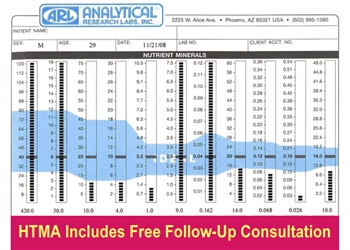All About Hair Sampling
HTMA: How to Collect Your Hair Sample
Kristina Amelong, CCT, CNC provides step-by-step instructions on how to collect your hair sample for the Hair Tissue Mineral Analysis (HTMA) and send it in to the lab. Each HTMA kit also includes detailed instructions, so make sure to read those too before collecting the hair sample!
▶︎ BUY HAIR TISSUE MINERAL ANALYSIS

The accuracy of a mineral analysis depends upon many factors. While the laboratory is responsible for the technical aspects of the test, the results will only be as good as the raw material or sample that is received. For this reason, the more care that is exercised by the person sampling the hair, the better the results will be.
Head Hair Versus Pubic Hair
The best tissue for sampling is one that is clean and fast-growing and one that grows evenly. Head hair fulfills these requirements better than any other type of hair. The normal values have been established based on head hair samples.
In the event that head hair is not available, pubic hair or other body hair may be used. Accutrace Laboratories has performed comparison testing to determine the differences in the mineral readings between head and pubic hair samples. The study found that the major ratios are the same in the pubic and head hair samples, however all of the levels tend to be higher in pubic hair. The difference may be due to the slower growth rate of pubic hair. It is important that you do not mix sample sources, such as half head hair and half pubic hair. This will produce unreliable test results.
Using Other Body Hair
We discourage the use of hair from a beard or other body hair.
Sampling The Hair
Quantity. Be sure to sample enough hair. The paper scale should tip to the other side. One of the most frequent problems at the laboratory occurs when too little hair is sent (less than 125 mg). Either the client must be contacted to send more hair, or the sample must be diluted, which reduces the accuracy. Also the laboratory normally keeps some hair to re-run any mineral that falls outside a reasonable range. If the sample is too small, extra hair cannot be saved.
Scissors should be clean and sharp. Steel scissors are better than aluminum scissors. Cutting hair will dull scissors, which must be sharpened or replaced when this occurs. If plated scissors are used, be sure the plating is not peeling off, which could contaminate the sample. Cut hair as close to the root as possible, then remove and discard the ends of the hair so that only the 1.5" segment closest to the root (scalp) is left. Use as many strands of hair as needed to tip the scale, all segments should be approximately 1.5 inches in length.
Short hair can be a challenge. A thinning shears is often helpful. Thinning will allow a more even sampling without leaving any "holes". Thinning shears are best when the hair is less than 1.5" long. One method is to make a cut with the thinning shears. Then pull the scissors away from the head, holding them parallel to the head. The cut hair will come away in the scissors and can be scraped into the envelope. It may also be necessary to run a comb through the hair after cutting, to remove the rest of the cut hair.
Washing. Hair should be dry when it is being sampled. Otherwise it cannot be weighed correctly. The sample should be taken between 4and 20 hours after washing. This allows the hair to re-equilibrate after washing. Hair that has not been washed for more than 4 or 5 days is more prone to environmental contamination. If a salt-based water softener is used in the home, hair sodium levels may be affected.
Storing samples. Samples can be stored if needed, as hair does not deteriorate with time.
Retest samples should be taken from the same area as the original sample, if at all possible. This assures continuity from sample to sample. However, it is not necessary to find the precise strands of hair for the next retest. Simply take the sample from the same general area.
Retests must be performed within two years of original test.
Animal samples. Before sending in a sample for an animal, call Analytical Research Labs for specific instructions.
Hair Treatments
Most shampoos, rinses, conditioners, tints, sprays, and other hair products don't affect the test for three reasons. First, most of these products do not contain metals, which is all the hair test measures.
Second, hair is only 10-15% porous. This means that not very much is absorbed by the hair itself. (The scalp is porous and can absorb many chemicals.) Finally, most shampoos are only applied for 15-30 seconds, not long enough for much absorption to take place.
Grecian Formula contains lead and should be avoided. Head and Shoulders Shampoo contains zinc and could elevate zinc readings. Selsun Blue Shampoo contains selenium and could elevate this reading.
"Home" dye/color products do not alter the test appreciably. However, it is best to wash the hair at least 6-8 times after a color treatment before sampling. After a beauty parlor permanent or bleach treatment, ideally it would be best to let the hair grow out 6-8 weeks. However, you may make a clinical decision that it is not possible to wait this long. The test may not be as accurate in this case, but the readings can still be very useful.
Heavy sweating just before sampling can increase sodium and potassium readings. Swimming in pools can increase your levels of copper and sodium.
▶︎ BUY HAIR TISSUE MINERAL ANALYSIS
|